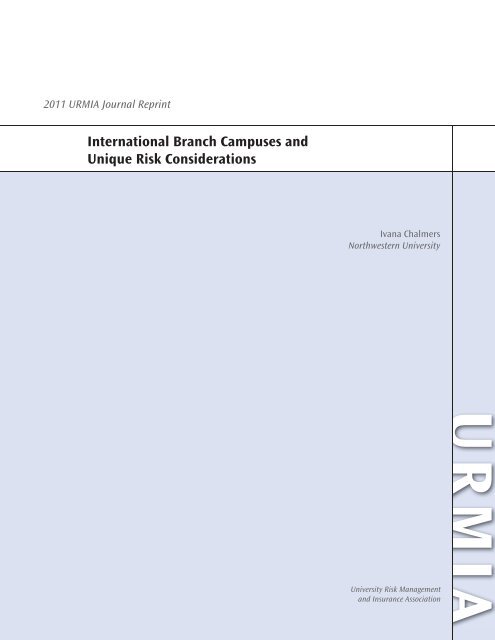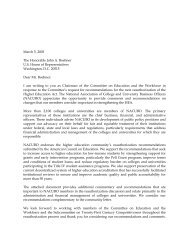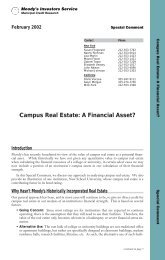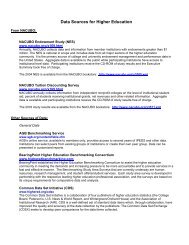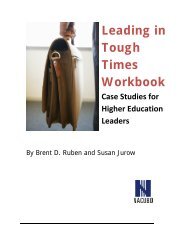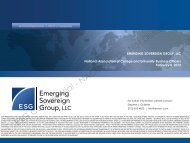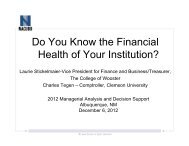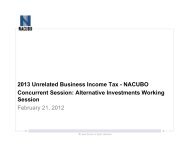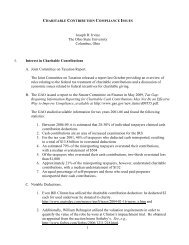International Branch Campuses and Unique Risk ... - NACUBO IRC
International Branch Campuses and Unique Risk ... - NACUBO IRC
International Branch Campuses and Unique Risk ... - NACUBO IRC
Create successful ePaper yourself
Turn your PDF publications into a flip-book with our unique Google optimized e-Paper software.
2011 URMIA Journal Reprint<br />
<strong>International</strong> <strong>Branch</strong> <strong>Campuses</strong> <strong>and</strong><br />
<strong>Unique</strong> <strong>Risk</strong> Considerations<br />
Ivana Chalmers<br />
Northwestern University<br />
University <strong>Risk</strong> Management<br />
<strong>and</strong> Insurance Association<br />
URMIA
Every human being has a work to carry on within, duties to<br />
perform abroad, influence to exert, which are peculiarly his,<br />
<strong>and</strong> which no conscience but his own can teach.<br />
—WILLIAM ELLERY CHANNING (1780–1842),<br />
UNITARIAN PREACHER
<strong>International</strong> <strong>Branch</strong> <strong>Campuses</strong> <strong>and</strong> <strong>Unique</strong> <strong>Risk</strong> Considerations<br />
Ivana Chalmers, Northwestern University<br />
Abstract: A very unique set of considerations may influence<br />
the ability of an international branch campus to meet its<br />
objectives <strong>and</strong> attain long-term success. After briefly examining<br />
the context-dependent nature of a branch campus, this<br />
article outlines examples of unique risks that may affect a<br />
branch campus’ operations. Finally, readers will review the<br />
valuable input that home campuses <strong>and</strong> d other collaborators<br />
can provide in managing the operations of<br />
international branch campuses.<br />
Introduction: <strong>Branch</strong> <strong>Campuses</strong> Are<br />
Increasing in Number<br />
Institutions of higher education based in<br />
the United States (US) continue to inate the number of established international<br />
campus operations outside of their<br />
home country. Currently, US institutions tions<br />
dom-<br />
have established almost 50 percent of<br />
all international branch campuses. 1 The<br />
University of Kentucky’s White Paper<br />
on <strong>International</strong>ization purports that in<br />
order for the United States to maintain<br />
its global leadership <strong>and</strong> influence in<br />
all spheres, it is essential for its higher<br />
education sector to continue looking outward<br />
globally. 2 While global leadership might be a driver<br />
resulting in the dominance of US-based institutions in the<br />
branch campus market, it is clear that these institutions<br />
are recognizing <strong>and</strong> attempting to meet specific needs.<br />
Today’s students are more globally mobile 3 <strong>and</strong> believe<br />
that exposure to cultures <strong>and</strong> languages other than their<br />
own are important factors to their success in the job market.<br />
4 Furthermore, governments are increasingly investing<br />
in education, seeing it as a catalyst in transforming their<br />
countries’ economies <strong>and</strong> putting them on the map. 5<br />
The desire to be recognized as an international higher<br />
education hub is clearly evident in countries such as the<br />
United Arab Emirates (UAE). With 40 international<br />
branch campuses within its borders, the UAE hosts approximately<br />
one quarter of all such ventures in the world. 6<br />
Today’s students<br />
believe that exposure<br />
to cultures <strong>and</strong><br />
languages other<br />
than their own are<br />
important factors to<br />
their success in the<br />
job market.<br />
The small neighboring country of Qatar hosts at least nine<br />
international branch campuses. A desire to legitimately<br />
qualify the national population for work in the growing<br />
mixed <strong>and</strong> private sectors largely drives this country’s<br />
education policy, 7 stimulated by wealth generation from<br />
prodigious natural gas reserves. In Qatar, international<br />
branch campuses are seen as long-term consultants. 8<br />
While the international branch<br />
campus market has become more competitive,<br />
there have also been campus<br />
closures, confirming the need for univer-<br />
sities<br />
to undertake cautious market research<br />
before making a decision to open a<br />
branch campus. 9 Lack of commonalities<br />
between the different contexts <strong>and</strong> loca-<br />
tions<br />
for branch campuses highlights the<br />
need<br />
for guidelines or best practices that<br />
can inform decision making for universi-<br />
ties considering such ventures.<br />
<strong>Branch</strong> <strong>Campuses</strong> Have<br />
<strong>Unique</strong> Contexts<br />
The nature of operations at satellite campuses,<br />
or branch campuses, as they shall<br />
be referred to throughout this article,<br />
are significantly ifi context-dependent. <strong>Campuses</strong> recruit<br />
employees from both local <strong>and</strong> international resource<br />
pools, <strong>and</strong> the student population is likely to be a mix<br />
of local nationals, study abroad individuals, <strong>and</strong> locally<br />
based expatriate students whose families are in the region.<br />
Differences between branch campuses are so acute that no<br />
official comprehensive list of all branch campuses in the<br />
world exists. 10<br />
The Observatory on Borderless Higher Education<br />
offers the following definition for international branch<br />
campuses:<br />
“An international branch campus is an off-shore<br />
entity of a higher education institution operated<br />
by the institution or through a joint venture in<br />
which the institution is a partner (some countries<br />
URMIA Journal 2011<br />
33
equire foreign providers to partner with a local<br />
organization) in the name of the foreign institution.<br />
Upon successful completion of the course<br />
program, which is fully undertaken at the unit<br />
abroad, students are awarded a degree from the<br />
foreign institution.” 11<br />
Quality <strong>and</strong> Content of Programming<br />
Particularly in instances of any kind of sponsorship<br />
or financial support from a host or partner, whether<br />
an educational, corporate, or governmental entity, the<br />
branch campus should have responsibility of the con-<br />
A branch campus can also be defined as providing<br />
“small, specialized, <strong>and</strong> limited academic programs offered<br />
offshore to take advantage of a perceived market.” 12<br />
The success of these “offshoots” of the home campus,<br />
or the original institution, also depends on the factors <strong>and</strong><br />
conditions under which the branch camepus<br />
is required or expected to operate.<br />
<strong>Branch</strong> <strong>Campuses</strong> Have<br />
<strong>Unique</strong> <strong>Risk</strong> Implications<br />
As a result of their unique context,<br />
branch campuses can be exposed to a<br />
range of unique risks. A branch campus<br />
might be a private, profit earning venture;<br />
a partnership with a local institution;<br />
or entirely sponsored by a local<br />
government or corporate entity. Each of<br />
these contexts brings with it unique risk<br />
considerations. As such, home campus<br />
risk management frameworks may fail<br />
to transplant successfully to the branch<br />
campus.<br />
In establishing a branch campus, the<br />
home campus should gear risk management<br />
measures towards aligning the institution with<br />
its goals, values, <strong>and</strong> mission 13 <strong>and</strong> meeting established<br />
benchmarks that underpin the progress of such an operation.<br />
In doing so, the home campus may also minimize the<br />
impact of any potential risk – risk that may be reputational,<br />
strategic, financial, or regulatory in nature.<br />
A set of goals that a home campus may have with<br />
respect to their branch campus include:<br />
• Maintaining the quality of the degree from the<br />
branch campus so that it is comparable to the<br />
same degree from the home campus.<br />
• Protecting institutional knowledge <strong>and</strong> business<br />
continuity by minimizing the turnover of employees<br />
during the critical startup period.<br />
A branch campus is<br />
an off-shore entity of<br />
a higher education<br />
institution operated<br />
by the institution<br />
or through a joint<br />
venture in which<br />
the institution is a<br />
partner.<br />
• Meeting any requirements or benchmarks of a<br />
host or sponsor to ensure sustained funding support.<br />
• Protecting the home campus from risks as a result<br />
of branch campus activities.<br />
Each of the above goals is examined in more detail<br />
below to better illustrate some of the unique risk implications<br />
for branch campus operations.<br />
Maintaining Degree<br />
Quality:<br />
A Reputational <strong>Risk</strong><br />
Consideration<br />
Institutions considering establishment of<br />
branch campuses should remain sensi-<br />
tive to the factors that may diminish<br />
the quality of their degrees, ultimately<br />
impacting the reputation of the home<br />
campus. Such factors include the quality<br />
of teaching <strong>and</strong> programming, access to<br />
resources, <strong>and</strong> official recognition.<br />
Quality <strong>and</strong> Retention of Faculty<br />
Frequently, institutions hope to have<br />
home campus faculty teaching at branch<br />
campuses, a model that is prevalent in<br />
Asia <strong>and</strong> the Middle East. 14 However,<br />
recruitment <strong>and</strong> retention of such faculty<br />
is an ongoing issue of sustainability, particularly<br />
if international engagement is<br />
not recognized as valuable in tenure <strong>and</strong><br />
promotion criteria. 15 Moreover, senior<br />
faculty members are often reluctant to leave their<br />
work, 16 alienate themselves from their colleagues, or<br />
lose momentum in their research.<br />
The ability of faculty to teach in a multilingual<br />
<strong>and</strong> multicultural environment will also likely impact<br />
the quality of teaching. Experience in this regard can<br />
prove very valuable in meeting the goal of maintaining<br />
degree quality.<br />
34 URMIA Journal 2011
trol of academic programming content <strong>and</strong> st<strong>and</strong>ards.<br />
The lack of control in this regard may pose significant<br />
risk to the quality of education at the branch campus.<br />
In addition, branch campuses in the Middle <strong>and</strong> Far<br />
East may face issues of censorship, something beyond<br />
the control of branch campuses or their hosts <strong>and</strong><br />
partners but with direct influence on academic freedom<br />
<strong>and</strong> the content of programming.<br />
Critical Resource Availability<br />
The ability to acquire books <strong>and</strong> equipment may<br />
have significant impact on the quality of teaching.<br />
Northwestern University faced resource acquisition<br />
challenges at the beginning of its establishment of<br />
a branch campus in Qatar. With degree offerings in<br />
communications <strong>and</strong> journalism studies, availability<br />
of media equipment was critical to course work.<br />
However, monopoly by a single vendor in the local<br />
marketplace meant that administration had to choose<br />
between spending 30 percent more to buy equipment<br />
locally or to ship it from known vendors overseas <strong>and</strong><br />
risk a longer delivery time <strong>and</strong> likely delay by customs<br />
upon entry.<br />
In conservative societies, customs officials may<br />
hold back educational materials containing nudity or<br />
political content. The host, sponsoring institution, or<br />
the appropriate governmental agency should seek support<br />
for the import of such materials prior to finalizing<br />
a branch campus agreement.<br />
Accreditation<br />
Accreditation by educational bodies in the university’s<br />
home country is an official recognition that<br />
the branch campus meets the goal of maintaining<br />
degree quality. Home campuses whose goals include<br />
accreditation of their branch campuses will need to<br />
consider the impact of accreditation requirements on<br />
their branch campus operations in terms of the time<br />
<strong>and</strong> effort required <strong>and</strong> make the ability to meet these<br />
requirements a key priority.<br />
George Mason University learned this lesson<br />
when, after almost four years of operation in the<br />
UAE, it was forced to close down in 2009 due to a 50<br />
percent reduction in its subsidy <strong>and</strong> pressure from the<br />
university’s sponsor, Edrak, that the branch campus<br />
academic dean report directly to Edrak instead of the<br />
university provost. The lack of resources <strong>and</strong> risk of<br />
losing accreditation due to the reporting structure<br />
forced the university to close its branch campus before<br />
it was able to produce a single graduate. 17, 18 George<br />
Mason University students could not transfer their<br />
credits to other Emirati institutions as the university<br />
was not yet locally accredited. 19<br />
The home campus should also take into account<br />
the accreditation requirements of the host country, if<br />
any such requirements do exist. While this might not<br />
influence the ability of a branch campus to meet its<br />
key goals or a sponsor’s requirements, it may allow for<br />
better integration in the host country’s higher education<br />
environment <strong>and</strong> gives students the opportunity<br />
to transfer from local institutions to the branch campus,<br />
opening another avenue for student recruitment.<br />
Maintaining Institutional Knowledge:<br />
A Strategic <strong>Risk</strong> Consideration<br />
Loss of staff naturally lends itself to the risks associated<br />
with loss of business continuity <strong>and</strong> institutional knowledge.<br />
In a startup environment of a branch campus, the<br />
likely chaotic <strong>and</strong> unstructured nature of operations may<br />
further increase this risk, as staff may encounter a stressful<br />
<strong>and</strong> less supportive environment than what they may<br />
encounter at more established higher education institutions.<br />
In setting up a branch campus, institutions should<br />
carefully manage employee expectations during recruitment<br />
<strong>and</strong> establish internal support systems.<br />
Implications on Recruitment<br />
While the home campus may expect branch campus<br />
employees to focus on the short-term goal of jumpstarting<br />
a new campus, it might also expect them to<br />
think strategically <strong>and</strong> build systems <strong>and</strong> processes<br />
that will serve the branch campus in the long-term.<br />
The home campus should communicate this unique<br />
set of expectations during the recruitment process so<br />
that staff members are better prepared to deal with<br />
the challenges during the critical startup period. The<br />
home campus should address these expectations in<br />
job descriptions <strong>and</strong> discuss them with potential staff<br />
during interviews.<br />
URMIA Journal 2011<br />
35
The home campus should also advise interviewees<br />
that they may encounter several duties that will<br />
fall outside of their natural scope of the job description.<br />
During the startup period at Carnegie Mellon<br />
University in Qatar, for instance, staff members in<br />
the human resources department were responsible<br />
for housing arriving employees, assisting them with<br />
obtaining identification <strong>and</strong> drivers’ licenses, finding<br />
schooling for children, <strong>and</strong> facilitating driving tests.<br />
Meeting Host or Sponsor Requirements:<br />
A Financial <strong>Risk</strong> Consideration<br />
One example of the importance of meeting the host country’s<br />
requirements is Johns Hopkins University’s medical<br />
program in Singapore. According to a University World<br />
News article, the home campus shut down the program<br />
because the local authorities did not feel the university<br />
If a branch<br />
campus is under<br />
consideration as<br />
a joint or entirely<br />
sponsored venture,<br />
universities should<br />
carefully consider<br />
the risks or impacts<br />
of loss of financial<br />
support.<br />
Internal Support Systems<br />
At a branch campus, employees<br />
may experience enhanced strain<br />
from working with collaborators<br />
from entirely different cultures <strong>and</strong><br />
experience levels. In addition to<br />
the unstructured <strong>and</strong> multicultural<br />
working environment, this stress s<br />
may also impact their personal lives<br />
via new living quarters, routines,<br />
pastimes, weather conditions, or laws<br />
<strong>and</strong> regulations.<br />
The branch campus can offer<br />
workshops <strong>and</strong> training addressing<br />
culture shock <strong>and</strong> dealing with<br />
significant change during the startup<br />
period to help alleviate the impact of<br />
the new environment on employee ee<br />
productivity in the workplace. In addition,<br />
branch campuses may offer a<br />
forum that allows employees to share<br />
their thoughts, frustrations, <strong>and</strong> cerns during this adjustment phase. This may be an<br />
con-<br />
excellent way for administration to better underst<strong>and</strong><br />
the measures that may minimize the effects of these<br />
issues on the workplace environment <strong>and</strong> the progress<br />
of the branch campus development.<br />
was meeting expectations, failing to reach eight out of 13<br />
performance benchmarks they originally set out. 20 Johns<br />
Hopkins’ administration believed this was an unfair judgment<br />
since the university had no control over the factors<br />
that led to its inability to meet those goals. This lack of<br />
control of an unfamiliar environment may pose a significant<br />
financial risk as host countries or sponsors may prove<br />
to be unsympathetic.<br />
If a branch campus is under consideration as a joint or<br />
entirely sponsored venture, universities should carefully<br />
consider the risks or impacts of loss of financial support.<br />
Sponsors want to see their investment<br />
realized <strong>and</strong> will most likely have expectations<br />
<strong>and</strong> requirements that the branch<br />
campus must meet in order to continue<br />
their support.<br />
Requirements for Student Recruitment<br />
Student recruitment may be one of the<br />
expectations or requirements set out by<br />
host or sponsors of international branch<br />
campuses. For instance, it is not unusual<br />
for hosts or sponsors to request admis-<br />
sions of students according to their<br />
ethnicity or nationality. In Qatar’s Educa-<br />
tion City, the focus is to educate the local<br />
population; therefore, the branch campus<br />
must admit a minimum number of local<br />
students to each of the six international<br />
branch campuses. 21 Requirements such<br />
as this may pose a risk to a branch cam-<br />
pus’ ability to reach the required volume<br />
of student numbers <strong>and</strong> may subsequently affect any<br />
profit earning needed for the campus to continue<br />
operations.<br />
Furthermore, comparatively high admissions<br />
st<strong>and</strong>ards of internationally accredited institutions<br />
may cause more students to opt for local providers<br />
of education <strong>and</strong> pose a risk to a campus’ ability<br />
to recruit required local students. As competition<br />
increases, these local institutions inevitably improve,<br />
further widening a student’s options for higher<br />
education in the region. 22 Universities may need to<br />
carefully balance host or sponsor student recruitment<br />
requirements against the risk to sustainability from a<br />
36 URMIA Journal 2011
competitive marketplace, especially since some regions<br />
are already heading for saturation of the higher education<br />
market. 23<br />
Liability Implications for the Home Campus:<br />
A Regulatory <strong>Risk</strong> Consideration<br />
<strong>Branch</strong> campuses may find themselves in a gray area in<br />
terms of regulatory risks. As part of the larger whole, they<br />
may have to conform to regulatory requirements of their<br />
countries of origin, while the capacity to address these requirements<br />
may not exist in their specific branch campus<br />
operational contexts.<br />
<strong>Branch</strong> campuses in countries whose legal systems<br />
differ significantly from that of the home campus may face<br />
risk simply because they may not be aware of how they are<br />
exposed. While the home campus might be able to enforce<br />
appropriate penalties regarding workplace harassment,<br />
discrimination, or breach of copyright, for instance, such<br />
issues may not have the same support of the legal system<br />
in the country of the branch campus. Despite the lack of<br />
equivalent legislative regulations in existence in Qatar,<br />
Northwestern University in Qatar has been asked by the<br />
Office of the General Counsel to produce proof of compliance<br />
with the Jeanne Clery Disclosure of Campus Security<br />
Policy <strong>and</strong> Campus Crime Statistics Act (Clery Act),<br />
Higher Education Opportunity Act (HEOA), Illinois<br />
Campus Security Act (CSEA), Family Educational Rights<br />
<strong>and</strong> Privacy Act (FERPA), <strong>and</strong> Health Insurance Portability<br />
<strong>and</strong> Accountability Act (HIPAA), to name a few.<br />
<strong>Branch</strong> <strong>Campuses</strong> Require <strong>Unique</strong> Support<br />
As is evident from the examples discussed, underst<strong>and</strong>ing<br />
the local operational context of a branch campus may<br />
prove vital to its success <strong>and</strong> long-term sustainability. Furthermore,<br />
branch campuses may require a unique range of<br />
support from both their home campuses <strong>and</strong> externally to<br />
mitigate the effects of risks on the attainment of key goals.<br />
<strong>Branch</strong> campus issues should be high on the agendas<br />
at the home campus for the first few years, <strong>and</strong> the home<br />
campus should empower a task force of committed internal<br />
stakeholders to provide support during this time. Just<br />
a few of the internal partners of Northwestern University’s<br />
branch campus in Qatar are listed in Figure 1 to illustrate<br />
the type of support that a home campus can provide.<br />
HOME CAMPUS<br />
DEPARTMENT<br />
Office of the<br />
General Counsel<br />
<strong>Risk</strong><br />
Management<br />
Academic Deans<br />
of the schools<br />
represented at<br />
branch campus<br />
FIGURE 1: INTERNAL SUPPORT FOR<br />
BRANCH CAMPUSES<br />
EXAMPLES OF<br />
SUPPORT SERVICES<br />
• Providing legal advice<br />
• Reviewing contracts<br />
• Reviewing waivers <strong>and</strong><br />
indemnification documents<br />
• Ensuring adherence to<br />
regulatory requirements<br />
• Reviewing <strong>and</strong> providing<br />
advice on insurance products<br />
• Supporting the creation of<br />
a branch campus insurance<br />
framework<br />
• Providing duty of care<br />
obligation advice<br />
• Supporting international<br />
travel risk mitigation<br />
• Supporting academic<br />
programming content<br />
• Assisting with home campus<br />
faculty recruitment<br />
Purchasing • Leveraging home campus<br />
vendors for services in branch<br />
campus location<br />
• Integrating purchase policies<br />
<strong>and</strong> procedures into branch<br />
campus environment<br />
Student Affairs • Helping create branch<br />
campus guidelines for student<br />
organizations<br />
• Creating synergies <strong>and</strong> student<br />
collaborations between<br />
campuses<br />
In addition to the valuable support given by collaborators<br />
from the home campus, the home campus can<br />
increase the likelihood of a branch campus’ success by the<br />
creation of local partnerships.<br />
Consultants can provide valuable input, as well. Consultants<br />
offer a variety of services <strong>and</strong> are often well-connected<br />
in the local context, providing important resources<br />
in advising the branch campus. An example would be a<br />
government liaison who can speak the local language <strong>and</strong><br />
assist the administration in dealing with legislative matters.<br />
Similarly, experienced security advisors can support<br />
the campus’ duty of care <strong>and</strong> emergency management<br />
URMIA Journal 2011<br />
37
efforts for a very globally mobile population, while legal<br />
consultants <strong>and</strong> insurance advisors can facilitate a better<br />
underst<strong>and</strong>ing of the local legal <strong>and</strong> insurance system <strong>and</strong><br />
mitigation of the subsequent risks.<br />
Furthermore, dialogue with other entities in the same<br />
operational environment could prove very useful. Other<br />
international branch campuses need not be competitors<br />
<strong>and</strong> may serve as strategic partners for mutual future<br />
success. Even non-academic entities, particularly global<br />
companies with the same country of origin as the home<br />
campus, may be a great resource to branch campus leaders,<br />
enhancing their underst<strong>and</strong>ing of operations in the local<br />
culture <strong>and</strong> context. Lastly, groups such as committees,<br />
task forces, research groups, <strong>and</strong> think tanks, whose focus<br />
is on long-term impacts <strong>and</strong> trends of higher education<br />
<strong>and</strong> the country in general, may provide valuable strategic<br />
insight for sustained future success of the branch campus.<br />
A Look to the Future<br />
As branch campuses increase in number in the international<br />
market, their experiences will continue to inform<br />
discussions <strong>and</strong> improve the ability of higher education<br />
decision makers to make the right choices when considering<br />
whether to establish branch campus agreements with<br />
partners, governments, educational bodies, <strong>and</strong> corporate<br />
entities. Case studies from real experiences will also provide<br />
insights into particular geographical locations <strong>and</strong> the<br />
unique risk implications for those contexts. As the international<br />
higher education market reaches saturation points,<br />
the continued success of established branch campuses<br />
despite the competition may depend on the ability of<br />
home campuses to provide the right kind of support <strong>and</strong><br />
the ability of branch campuses to meet their objectives,<br />
manage exposures to risk, <strong>and</strong> build key relationships with<br />
partners on the ground.<br />
About the Author<br />
Ivana Chalmers has worked at<br />
Northwestern University in Qatar<br />
(NU-Q) since its inaugural year of<br />
2008. NU-Q provides undergraduate<br />
degrees in journalism <strong>and</strong> communications.<br />
With a diverse employee<br />
community <strong>and</strong> students of 24 different<br />
nationalities, this unique environment<br />
results in a one of a kind operational context. Ms.<br />
Chalmers is the risk assessment specialist for the branch<br />
campus.<br />
At NU-Q, Ms. Chalmers’ portfolio encompasses a<br />
wide range of duties in a risk environment where precedents<br />
are rare, established policies may be unsuitable,<br />
<strong>and</strong> the context differs starkly from that of Northwestern’s<br />
home campus. Her role includes assessment of risk exposures<br />
<strong>and</strong> evaluation of insurance needs for the campus,<br />
while serving as a point of contact to internal <strong>and</strong> external<br />
security, legal, <strong>and</strong> risk management stakeholders. She is<br />
a key contact for <strong>and</strong> a member of several security, safety,<br />
<strong>and</strong> emergency management committees.<br />
Before joining NU-Q, Ms. Chalmers worked in the<br />
corporate media industry in London, Engl<strong>and</strong>, <strong>and</strong> Johannesburg,<br />
South Africa.<br />
In 2010, Ms. Chalmers co-published a chapter for a<br />
book, Girl Wide Web 2.0: Revisiting Girls, the Internet <strong>and</strong><br />
the Negotiation of Identity, edited by Sharon Mazzarella,<br />
about young Arab women <strong>and</strong> their use of social networking<br />
sites for expression of identity, entitled “Degrees of<br />
Caution: Arab Girls Unveil on Facebook.” This work was<br />
awarded the honor of ‘top paper’ in its category by the<br />
National Communications Association (NCA), <strong>and</strong> Ms.<br />
Chalmers presented it at the 2010 NCA conference in<br />
San Francisco.<br />
Ms. Chalmers is currently working towards a Strategic<br />
Decision Making <strong>and</strong> <strong>Risk</strong> Management professional certificate<br />
through Stanford University <strong>and</strong> holds a GCMBE<br />
Level II Project Management certificate from Meeting<br />
Professionals <strong>International</strong> (MPI). She graduated top of<br />
her class from Rhodes University in Grahamstown, South<br />
Africa, with a bachelor’s degree in journalism <strong>and</strong> media<br />
studies, specializing in television production.<br />
38 URMIA Journal 2011
Endnotes<br />
1<br />
Rosa Becker, “<strong>International</strong> <strong>Branch</strong> <strong>Campuses</strong>: Trends <strong>and</strong> Directions,”<br />
<strong>International</strong> Higher Education 58 (Winter 2010): 4.<br />
2<br />
<strong>International</strong>ization Task Force Membership 2007-2009, “University of<br />
Kentucky White Paper on <strong>International</strong>ization,” http://www.uky.edu/ITF/<br />
documents/Final_White_Paper_on_<strong>International</strong>ization.pdf, 4.<br />
3<br />
John K. Hudzik, Comprehensive <strong>International</strong>ization: From Concept to Action<br />
(Washington: NAFSA: Association of <strong>International</strong> Educators, 2010), 7.<br />
4<br />
Ibid., 11.<br />
5<br />
Andrew Mills, “Failure of George Mason U’s Persian Gulf Campus<br />
Sparks Concerns About Overseas Ventures,” The Chronicle of Higher<br />
Education, March 6, 2009, http://chronicle.com/article/Failure-of-George-<br />
Mason-U/117142/.<br />
6<br />
Becker, “<strong>International</strong> <strong>Branch</strong> <strong>Campuses</strong>,” 4.<br />
7<br />
Spencer Witte, “Gulf State <strong>Branch</strong> <strong>Campuses</strong>: Global Student Recruitment,”<br />
<strong>International</strong> Higher Education 58 (Winter 2010): 5.<br />
8<br />
Witte, “Gulf State <strong>Branch</strong> <strong>Campuses</strong>,” 6.<br />
9<br />
Becker, “<strong>International</strong> <strong>Branch</strong> <strong>Campuses</strong>,” 4.<br />
10<br />
Ibid., 3.<br />
11<br />
Philip G. Altbach, “Why <strong>Branch</strong> <strong>Campuses</strong> May Be Unsustainable,”<br />
<strong>International</strong> Higher Education 58 (Winter 2010): 2.<br />
12<br />
Ibid., 2.<br />
13<br />
John McLaughlin, “Road to Implementation: Enterprise <strong>Risk</strong> Management<br />
for Colleges <strong>and</strong> Universities,” Gallagher Higher Education Practice, 2009,<br />
10.<br />
14<br />
Madeleine F. Green <strong>and</strong> Kimberly Koch, “US <strong>Branch</strong> <strong>Campuses</strong> Abroad,”<br />
ACE Issue Brief (September 2009), 6.<br />
15<br />
Hudzik, Comprehensive <strong>International</strong>ization, 30.<br />
16<br />
Altbach, “Why <strong>Branch</strong> <strong>Campuses</strong>,” 2.<br />
17<br />
Mills, “Failure of George Mason.”<br />
18<br />
Tamar Lewin, “George Mason University, Among First With an Emirates<br />
<strong>Branch</strong>, Is Pulling Out,” The New York Times, March 1, 2009.<br />
19<br />
Ibid.<br />
20<br />
Altbach, “Why <strong>Branch</strong> <strong>Campuses</strong>,” 2.<br />
21<br />
Qatar Foundation Home Page, http://www.qf.org.qa/output/page3.asp.<br />
22<br />
Altbach, “Why <strong>Branch</strong> <strong>Campuses</strong>,” 3.<br />
23<br />
Jack Stripling, “Gulf Withdrawal,” Inside Higher Ed, February 7, 2009,<br />
http://www.insidehighered.com/news/2009/02/27/mason.<br />
URMIA Journal 2011<br />
39
©<br />
The URMIA Journal is published annually by the University <strong>Risk</strong> Management<br />
<strong>and</strong> Insurance Association (URMIA), PO Box 1027, Bloomington, IN 47402-<br />
1027. URMIA is an incorporated non-profit professional organization.<br />
The 2011 URMIA Journal was edited by Christie Wahlert, URMIA, Bloomington,<br />
Indiana; the covers were designed by Ellen Rising Morris of Eighth Day<br />
Creations, Wheaton, Illinois; <strong>and</strong> the URMIA Journal was printed at Indiana<br />
University Printing Services, Bloomington, Indiana.<br />
There is no charge to members for this publication. It is a privilege of membership,<br />
or it may be distributed free of charge to other interested parties.<br />
Membership <strong>and</strong> subscription inquiries should be directed to the National<br />
Office at the address above.<br />
© LEGAL NOTICE AND COPYRIGHT: The material herein is copyright July<br />
2011 URMIA; all rights reserved. Except as otherwise provided, URMIA grants<br />
permission for material in this publication to be copied for use by non-profit<br />
educational institutions for scholarly or instructional purposes only, provided<br />
that (1) copies are distributed at or below cost, (2) the author <strong>and</strong> URMIA are<br />
identified, (3) all text must be copied without modification <strong>and</strong> all pages must<br />
be included; <strong>and</strong> (4) proper notice of the copyright appears on each copy. If<br />
the author retains the copyright, permission to copy must be obtained from<br />
the author.<br />
Unless otherwise expressly stated, the views expressed herein are attributed<br />
to the author <strong>and</strong> not to this publication or URMIA. The materials appearing<br />
in this publication are for information purposes only <strong>and</strong> should not be<br />
considered legal or financial advice or used as such. For a specific legal or<br />
financial opinion, readers should confer with their own legal or financial<br />
counsel.
URMIA National Office<br />
P.O. Box 1027<br />
Bloomington, Indiana 47402<br />
www.urmia.org


